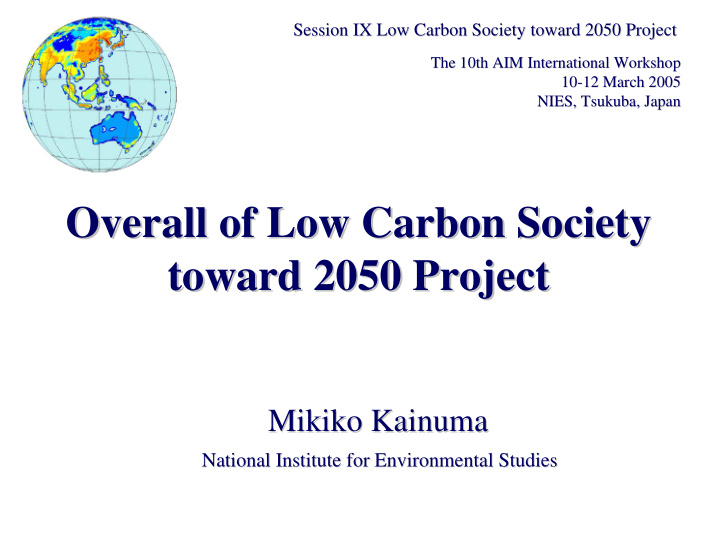



Session IX Low Carbon Society toward 2050 Project Session IX Low Carbon Society toward 2050 Project The 10th AIM International Workshop The 10th AIM International Workshop 10- -12 March 2005 12 March 2005 10 NIES, Tsukuba, Japan NIES, Tsukuba, Japan Overall of Low Carbon Society Overall of Low Carbon Society toward 2050 Project toward 2050 Project Mikiko Kainuma Mikiko Kainuma National Institute for Environmental Studies National Institute for Environmental Studies
Japanese climate policy scenarios toward 2050 Background: - UK, Germany, France, Sweden,,,,: Long term climate strategies, reducing GHGs drastically toward 2050. Are those the paths we should follow? - In UNFCCC and Japan: Beyond Kyoto Issue started. Quantitative base required. Goal: - To explore the possible paths to low carbon society in Japan toward 2050. - Major output: GHG emission scenarios - Various related research works. - How should we set policy target? (stabilization target, international burden sharing, sustainable development,,) - What technological and societal changes need to be introduced and how? (Options, Policy and Measures) - What implications these scenarios pose to future Japanese economy and society? (Evaluation of policies)
Japanese climate policy scenarios toward 2050 Japanese climate policy scenarios toward 2050 Study Japanese options toward climate sustainability Techno-socio Innovation Study EE Improvement Eco awareness Low-CO 2 emission car New tech application Smooth mobility Next generation car New Urban structure Industry efficiency New traffic system Urban structure IT-society Traffic system Reduction GHG emission Target study Develop socio- BaU scenario economic scenario, Tech. innovation Valid evaluate counter- EE improvement 5 Energy saving 3 Structure change measures using 1 New energy econ-techno models Effective Equity Life-style -1 change GHG reduction target Long-term ( eg. 50-80% reduction by 1990 level ) Suitable Intervention Evaluate rationality Scenario scenario and process of GHG 2010 2050 1990 2000 2020 Development reduction target Study Loge-term Middle-term Target year Target year Advisory board : advice to project Propose the direction of long-term global warming policy
AIM models for • Threshold of Climate Change • Stabilization path and impacts • Burden sharing 2050 scenarios • Analyzing stabilization path Countermeasures in each sector • Burden sharing, AIM/CGE[global] AIM/Impact[Policy] flexibility • Change of trade scheme like FTA Scenario Team Quantitative targets of Socio-economic 1 BaU scenarios AIM/Material indicators • Adjustment of social and Permanent economical scenario • Including industry structure production sector change and tech. innovation • Impact of GHG reduction Demand related to Adhoc production/ policy (constraint, tax, etc) Istituteion sector energy, urban, transportation, etc Household model • Quantitative analysis of AIM/Enduse countermeasures 2 Database Development • Database of countermeasures E D B • Interface with each sector Environmental option DataBase 3 Design of Low Carbon Society Scenarios
Change rates of energy/carbon intensity Change rate of energy intensity (%/year) Japan (1990–2000) 5 0 % r e 6 0 d 0 u % c t Change in carbon intensity i 1960-2000 Switchover r o 1960-2000 e n d excluding carbon capture u 7 c and storage (CCS) 0 t % i o n (1990–2000) r e France B2 d Change in carbon intensity u c with CCS t i o –1 n Revival UK 8 0 (1990–2000) % 1960-2000 Saving energy r e Historical change rates for d u Combine option c the past 40 years, and t i o projections, are connected n with change rates in the –2 1990s. Dashed lines, Germany 9 having a lope of -1, 0 (1990–2000) % represent positions in r e d which a 50-90% reduction u c is achieved over 50 years t i o n with 1% GDP growth. –3 –3 –2 –1 0 (Source: Kawase et al. 2005) Change rate of carbon intensity (%/year)
Path toward Low Carbon Society Masui:AIM20005 400 400 400 350 350 350 CO2 emissions [MtC] reference case reference case 300 300 300 250 250 250 ↓ 40% reduction policy case policy case 200 200 200 ↓ 60% reduction 150 150 150 low carbon case low carbon case 100 100 100 ↓ 80% reduction 50 50 50 0 0 0 2000 2005 2010 2015 2020 2025 2030 2035 2040 2045 2050 2000 2005 2010 2015 2020 2025 2030 2035 2040 2045 2050 2000 2005 2010 2015 2020 2025 2030 2035 2040 2045 2050 年 Year Urban System Change Urban System Change Industry Structure Change Industry Structure Change Energy Saving devices Energy Saving devices Information Technology nformation Technology I Energy Supply change Energy Supply change Renewable energy Renewable energy Consumption Behavior Consumption Behavior
Recommend
More recommend